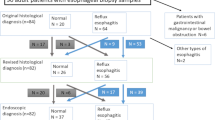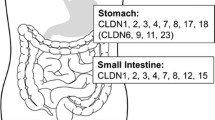Abstract
Background
The esophageal tight junction is responsible for the paracellular sealing of the epithelium. Alteration of the expression of tight-junction proteins plays crucial roles in the pathogenesis of some human diseases. The aim of this study was to investigate the distribution and expression pattern of tight-junction proteins in the esophageal mucosa of control rats and rats with reflux esophagitis.
Methods
Chronic acid reflux esophagitis was experimentally induced by operation in rats. The animals were killed on days 7 and 14 after the operation. The thickness of the mucosa and the 5-bromo-2-deoxyuridine (BrdU) labeling index were assessed. The expression pattern of the tight-junction proteins claudin 1-4 and occludin in the esophageal mucosa was investigated by immunofluorescence staining and Western blotting in the controls and esophagitis rats.
Results
In the esophagitis model, the thickness and BrdU labeling index increased with time. In control rats, claudin-1, -3, and -4 were localized on the cellular membranes of esophageal epithelial cells, mainly in the spinous and granular layers, while claudin-2 was not detected in any layer. Occludin was seen on the cellular membranes in all esophageal mucosal layers. In the esophagitis rats, the expression of claudin-1 was increased both in the plasma membrane and in the cytoplasm around the erosion in the spinous and granular layers. The expression of claudin-4 and occludin shifted to the cytoplasm from the plasma membrane in the spinous and granular layers. In contrast, the expression of claudin-3 was decreased in the spinous and granular layers.
Conclusions
The localization and the expression patterns of tight-junction proteins were different in the controls and the rat esophagitis model. The expression of claudin-3 in the esophageal mucosa was decreased, while that of claudin-1 was increased. It is postulated that these alterations in tight-junction proteins most likely increase the permeability of the esophageal the epithelium, thereby impairing the defense mechanism of this epithelium.
Similar content being viewed by others
References
RC Orlando ER Lacy NA Tobey K Cowart (1992) ArticleTitleBarriers to paracellular permeability in rabbit esophageal epithelium Gastroenterology 102 910–23 Occurrence Handle1537527
RC Orlando (1998) ArticleTitleReview article: oesophageal mucosal resistance Aliment Pharmacol Ther 12 191–7 Occurrence Handle10.1046/j.1365-2036.1998.00308.x Occurrence Handle9570252
D Hopwood KR Logan G Coghill IA Bouchier (1977) ArticleTitleHistochemical studies of mucosubstances and lipids in normal human oesophageal epithelium Histochem J 9 153–61 Occurrence Handle10.1007/BF01003627 Occurrence Handle65344
BA Hills (1994) ArticleTitleOesophageal surfactant: evidence for a possible mucosal barrier on oesophageal epithelium Aust N Z J Med 24 41–6 Occurrence Handle8002857
M Furuse K Fujita T Hiiragi K Fujimoto S Tsukita (1998) ArticleTitleClaudin-1 and -2: novel integral membrane proteins localizing at tight junctions with no sequence similarity to occludin J Cell Biol 141 1539–50 Occurrence Handle10.1083/jcb.141.7.1539 Occurrence Handle9647647
S Tsukita M Furuse (2002) ArticleTitleClaudin-based barrier in simple and stratified cellular sheets Curr Opin Cell Biol 14 531–6 Occurrence Handle10.1016/S0955-0674(02)00362-9 Occurrence Handle12231346
L Langbein C Grund C Kuhn S Praetzel J Kartenbeck JM Brandner et al. (2002) ArticleTitleTight junctions and compositionally related junctional structures in mammalian stratified epithelia and cell cultures derived therefrom Eur J Cell Biol 81 419–35 Occurrence Handle10.1078/0171-9335-00270 Occurrence Handle12234014
I Simonovic J Rosenberg A Koutsouris G Hecht (2000) ArticleTitleEnteropathogenic Escherichia coli dephosphorylates and dissociates occludin from intestinal epithelial tight junctions Cell Microbiol 2 305–15 Occurrence Handle10.1046/j.1462-5822.2000.00055.x Occurrence Handle11207587
S Sakisaka T Kawaguchi E Taniguchi S Hanada K Sasatomi H Koga et al. (2001) ArticleTitleAlterations in tight junctions differ between primary biliary cirrhosis and primary sclerosing cholangitis Hepatology 33 1460–8 Occurrence Handle10.1053/jhep.2001.25086 Occurrence Handle11391535
N Burgel C Bojarski J Mankertz M Zeitz M Fromm JD Schulzke (2002) ArticleTitleMechanisms of diarrhea in collagenous colitis Gastroenterology 123 433–43 Occurrence Handle10.1053/gast.2002.34784 Occurrence Handle12145796
T Kucharzik SV Walsh J Chen CA Parkos A Nusrat (2001) ArticleTitleNeutrophil transmigration in inflammatory bowel disease is associated with differential expression of epithelial intercellular junction proteins Am J Pathol 159 2001–9 Occurrence Handle11733350
N Omura H Kashiwagi G Chen Y Suzuki F Yano T Aoki (1999) ArticleTitleEstablishment of surgically induced chronic acid reflux esophagitis in rats Scand J Gastroenterol 34 948–53 Occurrence Handle10.1080/003655299750025020 Occurrence Handle10563662
A Lanas Y Royo J Ortego M Molina R Sainz (1999) ArticleTitleExperimental esophagitis induced by acid and pepsin in rabbits mimicking human reflux esophagitis Gastroenterology 116 97–107 Occurrence Handle9869607
F Ismail-Beigi PF Horton CE Pope Suffix2nd (1970) ArticleTitleHistological consequences of gastroesophageal reflux in man Gastroenterology 58 163–74 Occurrence Handle5413015
C Rahner LL Mitic JM Anderson (2001) ArticleTitleHeterogeneity in expression and subcellular localization of claudins 2, 3, 4, and 5 in the rat liver, pancreas, and gut Gastroenterology 120 411–22 Occurrence Handle10.1053/gast.2001.21736 Occurrence Handle11159882
M Furuse K Furuse H Sasaki S Tsukita (2001) ArticleTitleConversion of zonulae occludentes from tight to leaky strand type by introducing claudin-2 into Madin-Darby canine kidney I cells J Cell Biol 153 263–72 Occurrence Handle10.1083/jcb.153.2.263 Occurrence Handle11309408
C Van Itallie C Rahner JM Anderson (2001) ArticleTitleRegulated expression of claudin-4 decreases paracellular conductance through a selective decrease in sodium permeability J Clin Invest 107 1319–27 Occurrence Handle11375422
Y Kiuchi-Saishin S Gotoh M Furuse A Takasuga Y Tano S Tsukita (2002) ArticleTitleDifferential expression patterns of claudins, tight junction membrane proteins, in mouse nephron segments J Am Soc Nephrol 13 875–86 Occurrence Handle11912246
NA Tobey SS Hosseini CM Argote AM Dobrucali MS Awayda RC Orlando (2004) ArticleTitleDilated intercellular spaces and shunt permeability in nonerosive acid-damaged esophageal epithelium Am J Gastroenterol 99 13–22 Occurrence Handle10.1046/j.1572-0241.2003.04018.x Occurrence Handle14687135
NA Tobey JL Carson RA Alkiek RC Orlando (1996) ArticleTitleDilated intercellular spaces: a morphological feature of acid reflux-damaged human esophageal epithelium Gastroenterology 111 1200–5 Occurrence Handle8898633
C Calabrese A Fabbri M Bortolotti G Cenacchi A Areni C Scialpi et al. (2003) ArticleTitleDilated intercellular spaces as a marker of oesophageal damage: comparative results in gastro-oesophageal reflux disease with or without bile reflux Aliment Pharmacol Ther 18 525–32 Occurrence Handle12950425
M Jin E Barron S He SJ Ryan DR Hinton (2002) ArticleTitleRegulation of RPE intercellular junction integrity and function by hepatocyte growth factor Invest Ophthalmol Vis Sci 43 2782–90 Occurrence Handle12147616
M Hamaguchi Y Fujiwara T Takashima T Hayakawa E Sasaki M Shiba et al. (2003) ArticleTitleIncreased expression of cytokines and adhesion molecules in rat chronic esophagitis Digestion 68 189–97 Occurrence Handle10.1159/000075698 Occurrence Handle14691346
Author information
Authors and Affiliations
Rights and permissions
About this article
Cite this article
Asaoka, D., Miwa, H., Hirai, S. et al. Altered localization and expression of tight-junction proteins in a rat model with chronic acid reflux esophagitis. J Gastroenterol 40, 781–790 (2005). https://doi.org/10.1007/s00535-005-1628-6
Received:
Accepted:
Issue Date:
DOI: https://doi.org/10.1007/s00535-005-1628-6




